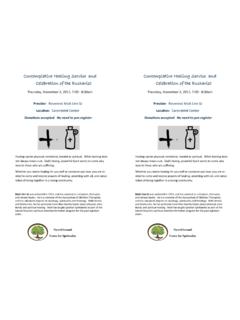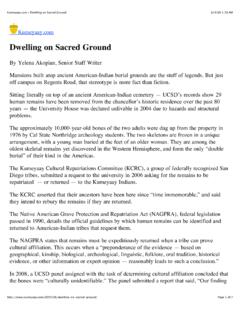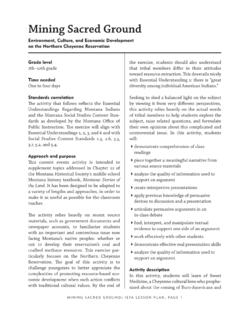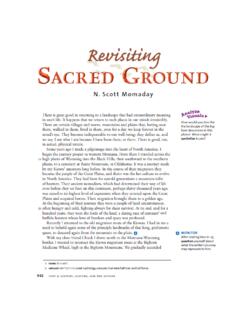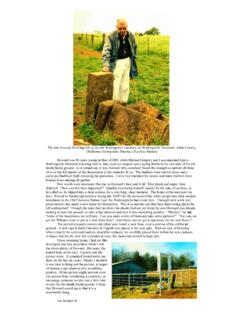Transcription of Revisiting Sacred Metaphors A Religious Studies ...
1 1 Revisiting Sacred Metaphors A Religious Studies Pedagogical Response to the Rise of the Nones Terry Shoemaker, Western Kentucky University William Simpson, Louisville, KY Abstract The emergence of the Religious nones can create pedagogical challenges due to the multifarious and institutionally disaffiliated nature of this classification. Thus, this article supplies a potential pedagogical technique by Revisiting Peter Berger s Sacred canopy metaphor . We submit that the Religious nones can be understood functionally and structurally by employing Sacred Metaphors based on the Sacred canopy. Three Metaphors are provided herein to address the three central categories of the nones: unaffiliated believers, agnostics, and atheists. We introduce these Sacred Metaphors , detail their relevance, and suggest that these Sacred Metaphors present a new way of explaining the complexities of classifying the Religious nones. Introduction A consensus regarding a definition of religion has eluded religion scholars since the early stages of the Religious Studies field.
2 A Religious Studies scholar might analytically approach religion in her own way, develop pedagogical techniques to discuss religion and its many features in her own context, or engender her own definition by amalgamating features from previous resources. In response to the plethora of available definitions of religion, some scholars have attempted to explain religion by employing Metaphors . Revisiting Sacred Metaphors Journal of Religion & Society 2 16 (2014) This paper proposes to advance the conversation regarding what we refer to as Sacred Metaphors , or word pictures attempting to provide a fundamental analogy for understanding religion. We shall briefly discuss two of the most well-known Metaphors Peter Berger s Sacred canopy and Christian Smith s Sacred umbrellas. These two Metaphors have played a vital role in how many scholars and students have understood Religious systems. We posit that both Metaphors , as thorough as they appear, are inadequate in light of the recent rise of Religious nones (those who report no Religious affiliation).
3 Thus, we examine the three dominant categories of the Religious nones and propose three new Metaphors for Religious structure of these three groups. Our intent is not to reject previous Metaphors or to provide comprehensive Religious Metaphors , rather we hope to expand the conversation pertaining to the functionality and structure of Metaphors of religion and possibly provide new heuristic devices for those instructing Religious Studies courses specifically introductory religion courses. Sacred Metaphors in Religious Studies In 1967, Peter Berger introduced the concept of the Sacred canopy. Berger s Sacred canopy metaphor painted a word picture for the functionality of religion. He proposed that religion serves to supply a legitimation against world disrupting anomie. By anomie, Berger meant anything disrupting the normal flow of a socially-constructed existence including natural phenomena, war, disaster, and death. Thus religion permits the individual .. to exist in the world of his society not as if nothing had happened, which is psychologically difficult in the more extreme marginal situations but in the knowledge that even these events or experiences have a place within a universe that makes sense (44).
4 Given the legitimating force of the Sacred canopy, Berger suggested that humankind maintains the Sacred canopy to serve as a barrier against the chaos that all humans will eventually face ultimately death. Consequently, the Sacred canopy supplies meaning for these events. In sum, the Sacred canopy provides the community epistemological reasoning to proceed with life as they know it, even in the event of disruptions. Thus Berger s functionality of religion encompasses sacrosanct, communal, and protective characteristics. These three elements fit nicely into Berger s Sacred canopy metaphor . Berger suggests that the canopy is Sacred in the sense that it provides epistemological and teleological assurance in this world. As such, Sacred is utilized as a way of describing a clarification of unexplainable events and access to, otherwise inaccessible, justifications. The second half of the analogy refers to the communal aspect of religion. The analogy denotes that historically religion has been a shared venture imparting all the aforementioned Sacred elements not simply to an individual, but to the collective.
5 Thus, the canopy furnishes a fairly complete picture of Religious functionality and structure drawing an image of a collective tribe huddled under the protective barrier attempting to escape, examine, and explain the inevitable dangers and death in this world. And if earthly dangers and death do impose themselves upon the collective (which they inevitably will), the canopy provides an explanatory barrier. Berger s metaphor is important, not only because it provides wonderful symbolism for the role of religion, but because it was an early attempt to develop a Sacred metaphor . By Sacred metaphor , we simply mean the development of an image to describe the function of Revisiting Sacred Metaphors Journal of Religion & Society 3 16 (2014) religion, while not intending to imply a consecrated nature to the metaphor itself. Like Talal Asad s statement, there cannot be a universal definition of religion (29), we posit that, likewise, no metaphor describing the functionality and structure of religion could ever be comprehensive; therefore, we admit that the proposed Sacred Metaphors herein inherently include a limitation in application.
6 As religion changes, inevitably, the modes of religion are altered. Hence, more recently, Christian Smith modified Berger s Sacred metaphor to describe the structural formation of religion contemporarily in the United States. Almost as an aside in his work, American Evangelicalism, Embattled and Thriving, Smith proposed a metaphor of Sacred umbrellas (106-107). His metaphor echoes much of Berger s with one major exception Smith advances that religion in the United States has become a utility for a smaller-scale collective, abandoning macro-level collective meaning. In essence, people don t need macro-encompassing Sacred cosmoses to maintain their Religious beliefs. They only need Sacred umbrellas, small, portable, accessible relational worlds .. under which their beliefs can make complete sense (106). Given that Smith s analytical focus was on evangelicalism in the United States, which maintains individual soteriology and has ingeniously adapted to the Religious marketplace (Lee and Sinitiere), the Sacred umbrella metaphor adequately describes the clustering of evangelical devotees into enclaves.
7 Yet the two Metaphors additionally denote something interesting about the nature of religion (and of Metaphors ). The modes of religion, when in flux, create a need for scholars to reconsider and develop additional Sacred Metaphors in response to the changing arrangements of religion. Simply stated, one Sacred metaphor cannot adequately encapsulate the myriad (and shifting) structures of religion. Indeed, broadly speaking, religion is changing in the United States. Adherents seek religion for many reasons and, as a result, religion is taking new forms. This holds true for many contemporary devotees, but quite possibly is more applicable for those categorized as the Religious nones. The Nones, Characteristic Similarities The Religious landscape in the United States currently is more diverse than it has ever been. A significant portion of this diversity is due to the fact that rates of Religious affiliation in the United States have been dropping significantly since the 1990s (Pew Forum 2009; WIN-Gallup International; Putnam and Campbell: 121-22).
8 The group of Americans who reject traditional Religious labels has become known as the nones (Putnam and Campbell). The percentage of those who claim no religion has grown even more rapidly in the over the past few years, from 16% in 2007 to nearly 20% in late 2012 (Pew Forum 2012). This swift and drastic movement away from traditional Religious affiliations has rightfully spurred much debate and research regarding the causes and implications of the rise of the nones. Many scholars have explored the social characteristics and tendencies of the nones in the As we will discuss in detail below, the nones are not a homogeneous or monolithic group. Still, they tend toward certain sociological features. For example, several Studies have corroborated that men, younger [people], those without children, those with higher levels of education, and those with a more liberal political stance are all more likely to claim no Revisiting Sacred Metaphors Journal of Religion & Society 4 16 (2014) religion (Baker and Smith 2009b: 1257).
9 Scholars have offered a number of interpretations of these characteristics. Nonreligion tends to be a male dominated orientation. Obviously this is (along with all of the following tendencies) only a statistical generalization and there are many exceptions. On the whole, men are more likely than women to be atheists (Cheyne and Britton) and are less likely to report themselves as being Religious (Zuckerman: 10). Some have suggested that certain personality traits that are more common in men may explain their higher rates of nonreligion. For example, men are on average less adept at mentalizing and, therefore, may be less likely to adopt Religious perspectives that involve a belief in unseen personalities such as gods, spirits, and demons (McCauley: 264-68). Young Americans are much more likely to report no Religious affiliation than are Americans of previous generations. In fact, the younger the individual, the more likely she will report no Religious label. Nearly a third (32%) of younger Millennials (born between 1990 and 1994) report no religion, while only 5% of the Greatest Generation (born between 1913 and 1927) identifies as nonreligious (Pew Forum 2012).
10 Greater amounts of nonreligion in young Americans seems to be the consequence of both generational replacement and disaffection of younger individuals who were raised within a Religious tradition (Pew Forum 2012). Another commonality of Religious nones is their lack of binding social ties. Parenthood increases the statistical likelihood that one will claim a Religious affiliation (Baker and Smith 2009b: 1257). Some have claimed that the lack of social obligations, such as marriage, strong friendships, and even stability of one s place of residence, are correlated with the likelihood that one will hold an atheistic worldview (Bainbridge). The question of whether or not these correlations represent causal relationships (and if so, which direction the causation goes) is still open, but the correlation is undeniable. Education, with regard to the Religious nones, is a complex characteristic. Across the board, the religiously unaffiliated only rank slightly higher than the general public in terms of education (Pew Forum 2012: 33).


